|
The CBA
Belgium Automated Supernova-Search Program
Amateur astronomers
play an important role in the discovery of
supernovae : the vast majority of supernovae
nowadays are found by amateurs, using CCD cameras
attached to small- or medium size telescopes (20-cm
to 60-cm). There are many different ways to
systematically search for supernovae, although most
methods share some fundamental characteristics. This
article provides a detailed description of the CBA
Belgium Automated Supernova Search Program, and
the way it has been conceived. We hope it will be an
inspiration to other amateur astronomers, who are
considering to start a similar search program.
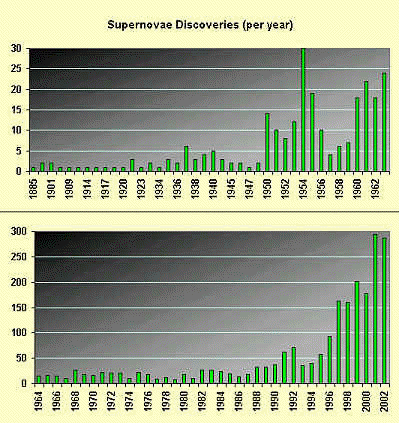 |
|
Discovering
supernovae in a successful way, requires are basic
understanding of what supernovae are - especially
the distinction between type Ia and type II
supernovae is essential to compile an intelligent
list of target galaxies. That's why this article
starts with a short explanation on the anatomy
of supernovae (chapter
1). The most critical step in
any supernova-search program is the selection of the
target galaxies. We list the parameters,
one has to consider for selecting galaxies and we describe how to compile a Search Program (chapter
2).
The rest of any
Supernova-Search Program is a combination of
hardware (chapter
3), software (chapter
4),
persistence and luck. Depending
on your telescope, mount, CCD camera and programming
skills, you might put together a search program
using commercial, off-the-shelf software building
blocks, or you might want to sophisticate and tune
the program to your individual needs, by writing your own
scripts or software. Ours is a combination of
commercial tools and own programming logic (chapter
4). |
|
Source: http://cfa-www.harvard.edu/iau/lists/Supernovae.html |
You're now ready to
kick off the actual supernova hunting, and to collect
large amounts of CCD images. The final bit of your
Supernova-Search Program will consist of methods and
tools to analyse images, and to compare them
with images acquired on previous occasions. Again,
there's a multitude of ways to do this
post-processing. We present our method as an example
(chapter
5).
You should of course
ask yourself what the scientific value is of
(discovering) supernovae (chapter
6). For some
amateurs, this will probably be the main motivator
to start a search program, for others it merely is
"good-to-know" stuff. We conclude (chapter
7) with a list of Internet references, that
are "musts" for any supernova (re)searcher.
1. Anatomy of
Supernovae
Supernovae (SN) are
massive exploding giant stars, existing either as a single star
or a binary system. They are so bright that they
can collectively outshine all the stars in their
host galaxy.
SN are divided into 2
basic physical types :
- Type Ia SN
are binary systems, in which a white dwarf orbits a
large, but less dense companion. Both stars are that close to each
other, that mass flows from the companion to the
white dwarf. After some time,
the dwarf star takes on more matter than its
supporting core can handle, causing it to go into
thermonuclear instability and it collapses. Those
are amongst the largest explosions in the universe.
- Type II SN
occur at the end of a massive star's lifetime, when
its nuclear fuel is exhausted. If the star's iron
core is massive enough, it will collapse, producing tremendous shock waves, and
become a supernova.
What happens after
the explosion of a SN, depends on the type and mass
of the progenitor star. Mostly, they produce a gas
cloud called a supernova remnant. A good
example of this is the Crab Nebula or
M1.
| Type II SN release more energy than Type Ia, but in
Type Ia SN the released energy is more in the form
of visible light, and therefore they are - generally
speaking - brighter than Type II SN. The diagram
at right shows a
comparison between the light intensity (luminosity) of type I and
type II SN, as a function of the number of days
since peak activity. Type I SN are much brighter but decay
much faster than type II SN. Type Ia SN all have
very similar lightcurves, whereas type II SN show many differences in
their lightcurves. A lot of type II SN have a "plateau" in the
2 months following the explosion.
|
|
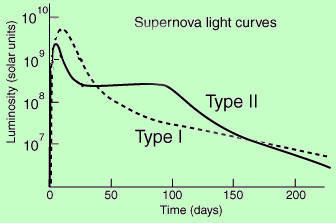 |
|
|
Adapted (and corrected) from
Chaisson & McMillan, Astronomy Today, 2nd Ed., Prentice-Hall,
(1997). |
2. Selecting
target galaxies
Beginning SN hunters typically select target galaxies according to their
brightness only. They build a list of bright galaxies and start hunting. This is a
quite inefficient selection procedure, seriously reducing
the chances on success. Compiling an
intelligent target list requires a
number of selection criteria to consider. The
criteria we use for our SN-search program are :
galaxy
distance, morphology or type, luminosity, size, inclination,
etc.
The best source to start from is the Third
Reference Catalogue of Bright Galaxies from G. De Vaucouleurs (1991),
mostly called the RC3 catalogue. It provides extensive data for 23022
galaxies.
a) Distance
The RC3 catalogue provides radial velocities
for many of its galaxies. Starting from the radial velocity, one can
derive the galaxy distance, using an (approximate) value of the Hubble
constant. Once you know the distance of a galaxy, you can determine the maximum
possible brightness of a type Ia and type II SN. Depending on the size of
your telescope, the sensitivity of your CCD and your local observing
conditions, you will notice that there's a cut-off point in distances. Simply
said : there's a whole series of galaxies that you can exclude from your
target list, because any supernova produced by such a galaxy will be
too faint to be discovered with your equipment.
b) Morphology
Type Ia SN require a
dwarf star with a companion star. In general, dwarf
stars are very old stars, and therefore type Ia SN
typically occur in older star populations in spiral
galaxies or elliptical galaxies. However, type II SN
are the result of quickly evolving young stars, and therefore happen in spiral
galaxies where star formation is still ongoing. They never appear in
elliptical galaxies.
To put it differently : spiral galaxies produce
both type Ia and type II SN, whereas elliptical galaxies only produce
type Ia SN. To maximize discovery chances, one might concentrate on spiral
galaxies only. We nevertheless recommend to include a fair amount of
elliptical galaxies in your target lists too, as type Ia SN have more
scientific value to astronomers (see chapter
6).
c) Luminosity
The frequency of SN explosions is directly
correlated to the luminosity of the host galaxy. This is quite logical : the
more stars in a galaxy, the higher the chances on having a SN amongst
them.
d) Size
Galaxies that are too small (major axis) should
be excluded from your target list as well. Again, use a cut-off point to
decide on this criterion, or divide galaxy sizes in classes (bands) giving a
weight to each class.
e) Inclination
This is a fairly obvious criterion, and for
most galaxies, you will find its inclination in the RC3 catalogue using the so
called "Log R25" value.
A formula for sifting
galaxies
It is obvious that the creation of an intelligent target list is not
straightforward, but the more energy you spend in making it as good as
possible, the better you maximize your discovery chances
afterwards.
The idea of building a "formula" to intelligently sift
galaxies from a catalogue came from Berto Monard, who told me he
was using this approach to quite some success. Such a formula combines
all of the above parameters, and for any given galaxy will return a
"probability number" indicating the chance on seeing a
SN in that particular galaxy.
I spent weeks building a suitable set of formulae in Excel, exchanging many emails with
Berto Monard. I finally came up with a formula that I tested on many of
the past SN discoveries, and very much to my satisfaction, the resulting
probability numbers were reliable and consistent. The biggest
problem in setting up the formula, was to decide on what to do if one or
more parameters are missing. In that respect, we recommend to complete
the RC3 catalog as much as possible with data coming from other sources,
before starting your selection process.
Try and build your own formula to do the
sifting. You can make it as complex as you want. For instance : for each
possible morphology type (we distinguish 40 different ones in our
formula), we are applying two "weight" factors : one for type
Ia SN and another for type II SN.
|
Once the sifting criteria were
determined, we applied them to the entire RC3
catalogue and eliminated all galaxies with a
probability number below a certain threshold. We then
sorted all target galaxies by minimizing the
slew time between objects, hence increasing the efficiency of
our robotic telescope mount. There is various ways
to accomplish this sorting job. We used Software
Bisque's TheSky.
The resulting sorted
Target Galaxies List then was split in Right
Ascension (RA) chunks of "2 hours" or
sometimes 3 hours. For each chunk, I produced an A
Program and a B Program. The A Program
consists of target galaxies with a probability
number above a certain threshold (highest SN
chances), and therefore is the more important one.
The B Program contains the remaining galaxies, and
is to be used on evenings when all A Program
galaxies have been exhausted.
Some numbers : on
average, a 2 hour chunk in my Supernova Search
Program consists of 100 to 150 galaxies. Evidently,
not all galaxies of the A Program can be visited in
the course of a month (e.g., some will be too close
to the Sun). I try to visit the A Program galaxies
twice a month, although I usually don't succeed, due
to the limited time I spend on SN hunting (to not
compromise my Cataclysmic Variables research), and -
more importantly - due to the very limited amount of
clear skies we have in Belgium.
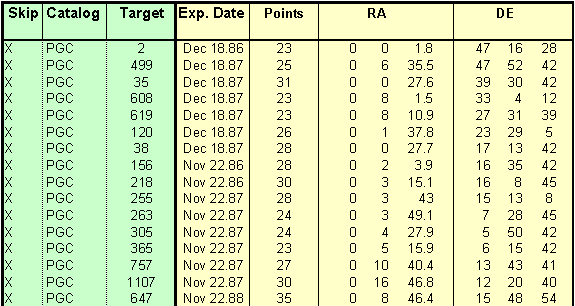 |
|
All my Target
Galaxies chunks are stored as Microsoft Excel
files. At left is an excerpt from the A Program chunk
for RA 0h to 2h.
The columns in
green color are the ones that contain input data
for my SNHunt program (see further). The
yellow columns consist of output produced by SNHunt
or comments.
|
|
Extract of
my A Program target galaxies list for RA 0h to
2h. Notice the Points
column, that contains the "Probability
Number" of each target galaxy. |
|
|
3. Telescope,
mount and CCD camera
In principle, any
telescope and CCD camera can be used to do supernova
hunting, as long as your mount points and tracks
well enough. Most amateurs are using a relatively
small SCT-type telescope with a sensitive CCD
(B&W).
However, the story
becomes a lot more complicated when you consider to automate
your SN-search program. First of all, you need an
accurate permanent mount with "GOTO"
capabilities. Precise tracking is of
paramount importance, as typical CCD exposure times
will be ranging from 40 till 100 seconds or more
(depending on the limiting magnitude you desire).
Next challenge is to bring your telescope, mount and
CCD camera in "perfect harmony",
i.e. you will need a software program that can sweep
your telescope to a target galaxy, make a CCD
exposure, store it away, and move on to the next
galaxy in a long list of targets to explore. A truly
automated SN-search program should be capable
of working autonomously for several hours on a row,
while you catch some sleep (especially if you must
get up and go to work the next morning).
All of the above
might sound fairly easy to accomplish and there's
indeed some good commercial mounts and software on
the market, that can do the job. I definitely would
recommend Software Bisque's mount/software
suite combination for any amateur considering
automated SN-searches.
My observatory setup,
however, was far more demanding, and I had to
overcome several hurdles, taking me many
months to complete a software program, that finally
automated my equipment to the desired level of
autonomy. Here's a quick overview of the most
important hurdles I encountered :
|
- my permanent mount
has limited tracking accuracy, and becomes
unreliable for unguided exposures above 30 seconds.
Since all of my SN CCD exposures are 60 seconds or
more, I had to find a way to automatically guide
every image. I'm using MaxIm DL/CCD for
camera control and imaging, and had to program it in
such a way that it would automatically identify a
suitable guide star for every image. But what to do,
if there's no guide star available ?
- my mount
is not perfectly polar aligned. As long as
the sweep distance between two successive targets is
relatively small, the target will end up in the CCD
frame. In all other cases, it won't. I have
written software to sync every CCD image with the
actual telescope position, and to correct if
necessary.
- my mount controller
sometimes "gets lost", that is :
every now and then, but unfortunately not
predictable, a sweep operation is terminated in RA,
a few RA minutes before or after the destination is
reached. Detecting such cases is hard, and it
took me lots of effort to enable my software to
finally recover from such situations.
|
4.
Software for automated SN searching
4.1
SNHunt - the heart of the CBA Belgium SN Search
Program
I am using a
combination of commercial software packages and
self-written programs to implement a fully automated
SN search program. These are the ingredients :
- CCD camera
control, imaging and guiding are all done using MaxIm
DL/CCD. MaxIm provides an ActiveX
Automation interface for externally controlling the
CCD camera operations. ActiveX is a
platform-independent method for linking different
applications together. I'm using Visual Basic to
completely control and automate MaxIm DL/CCD.
- Telescope
control (sweeping to target galaxies) is done
using the ASCOM (Astronomy Common Object
Model) platform. This is a set of technologies and
drivers that form the basis for interoperability
between ASCOM-based tools. The ASCOM Platform
supports a variety of telescope types via standard
drivers.
- Telescope
syncing (correlating a CCD image with the actual
position of the telescope) is done using TheSky.
TheSky has no direct automation interface for
external control, so I had to use other means to
tell TheSky what to do.
- Target galaxies
are loaded in my program as Microsoft Excel files
(see example in chapter
2).
I have written an
extensive Visual Basic program, called SNHunt,
to glue all of the above components together,
and to build in the logic to overcome all of
the (hardware) hurdles described in the
previous chapter.
|
SNHunt executes on
the laptop computer in my observatory. It
takes as input a simple Excel file with target
galaxies, and will slew the telescope from one
galaxy to the other (provided its altitude is
within a controlled range), instruct the CCD
camera to take a guided exposure, consult
TheSky to ensure that the CCD image contains
the target galaxy, and reposition the
telescope if needed.
On average, once the telescope
has been setup, it takes no more than 5 minutes to
slew to the first target galaxy, using SNHunt,
and kick-off a night's searching. |
|
 |
4.2
SNDashboard - to catch some safe sleep
In addition to the
above functions, SNHunt also produces a log file
with relevant information. That log file is
used by another software package, that I wrote,
called SNDashBoard. It follows-up and
controls the proper execution of the search in
real-time mode, using my home computer (connected to
the laptop computer in the observatory).
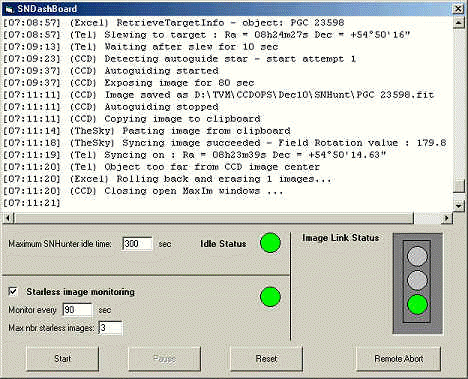 |
|
Amongst other
things, SNDashBoard monitors sky
conditions and a computer-controlled voice
will wake me up if clouds are entering the
sky. In fact, my wife and I have 2 baby phones
in our sleeping room : one to monitor our
youngest son, the other is connected to SNDashBoard.
The image at
left is a typical sample of SNDashBoard
in life operation. As long as the leds are all
green, the SN-search program is executing well
and no human interaction is required.
A "Remote
Abort" button allows to interrupt the
imaging sequence in the observatory, directly
from the home computer.
|
5.
Post Processing of Images
A successful observing
night will produce dozens of CCD images, that need
to be inspected for SN candidates. Although this
part of the search process can be automated too, I
prefer to visually inspect my CCD frames.
Nevertheless, I implemented a software tool that
brings a lot of relief to the inspection job.
The most important
step, evidently, is to compare your CCD images with reference
images. The internet provides instant access to
many professional sky surveys (e.g., the Digital Sky
Survey), that are tremendous tools for every
SN searcher. Yet, it is my experience that the best
reference images still are your own ones. I
therefore always first compare my CCD images with
own reference images, before moving on to
professional exposures.
SNViewer is
the software tool, that I wrote in Visual Basic, to
assist me with the post processing of my SN-search
images. It works in close conjunction with MaxIm
DL.
I first select the folder, that contains the images
to be explored (called the "Tonight
folder") and the folder containing the
reference images. I then follow a sequence of steps,
which is made explicit in SNViewer by
separate push buttons. Short :
- "Get Image
and calibrate" loads a new image from the
"Tonight folder" and opens it in MaxIm
DL, after which it is automatically corrected for
bias, dark frame and flat fielding.
Simultaneously, SNViewer loads a
corresponding DSS (Digital Sky Survey) image from
a library of images on my hard disk, showing the
same galaxy.
- "Get
reference" loads a reference image from my
references folder and opens that image in MaxIm DL
for a first visual comparison.
- "Blink
images" is an optional button that I can use
to aid the inspection. It will
overlay both images and "blink compare"
them.
- Sliders in SNViewer
allow to adjust the brightness, contrast and image
scale of the DSS reference image. This is
important as it allows to modify images to examine
both the core and the faint outer regions.
- Once an image has
been inspected, I use the "Save as
suspect", "Save as reference" or
"Archive" buttons to move the image
resp. to a folder with suspect images (possibly
containing a SN), to the reference folder (from
then on, the current image will act as reference)
or to an archive folder (for backup
purposes).
- One additional
button, worth mentioning, is "Create Priority
File". When pressing this button, my home
computer notifies SNHunt (chapter
4) executing on the laptop computer in the
observatory, that
a priority target has been identified, and that the
telescope has to move to the target, upon completion
of the current imaging sequence. This is especially worthwhile
to double check suspect images.
Using SNViewer, I can
process approximately 60 - 100 images per hour,
sometimes more.
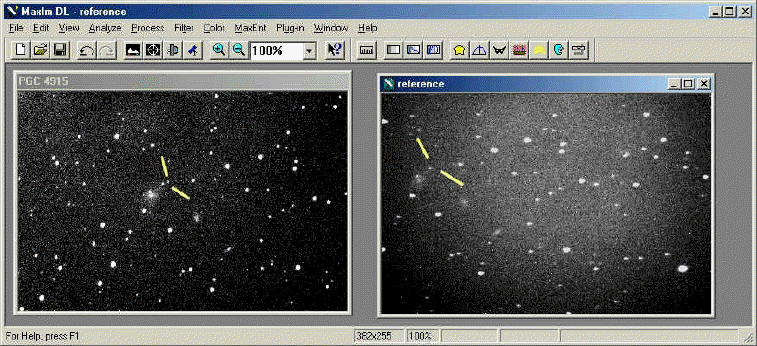
 |
|
The SNViewer
tool will load newly acquired CCD images one
after the other. Every image is presented in
MaxIm DL, together with a so called 'reference
image', acquired on previous occasions. In
addition, SNViewer will also load a Digital Sky
Survey image of the galaxy under investigation.
I have included a "blink images"
button in SNViewer, that allows to blink-compare
CCD images (by overlaying them). |
6.
Scientific value of SN hunting
Starting around 1933,
astronomer Fritz Zwicky was the first one to
extensively research SN. He not only coined the term
"supernova", but today he still is the
individual who holds the record of the most SN
discovered. Since the pioneering work of Fritz
Zwicky, the know-how on SN has vastly extended. It
is beyond the scope of this article to elaborate on
the physics of SN.
Yet, it is important
to realise that many SN questions are waiting for an
explanation. Hence, the discovery of SNe is still
attracting a lot of attention from the professional
astronomers community. The
importance of an automated SN-search program
therefore is to find SN shortly after they
explode, so that professionals can track the
exploding star over its entire cycle, and learn as much as
possible about the physics of supernovae, providing
clues to the fate of the cosmos.
There are many good
examples to illustrate the importance of SN
discoveries. Here is one, pointing at a recent and
very significant finding, made by two independent
teams of astronomers, studying distant SN. Type Ia
SN for quite some time are used as a "standard
candle" to estimate galactic distances.
Astronomer Alexei Filippenko (University of
California) and an international crew of astronomers
- the High-Z Supernova Search Team - drew
upon the distances of Type Ia supernovae to conclude
that the expansion of the universe is accelerating,
an observation that implies the existence of a
mysterious, self-repelling property of space first
proposed by Albert Einstein, which he called the cosmological
constant. Independently, the same conclusion was
reached by another team of astronomers, the Supernova
Cosmology Project.
7.
Internet references
Some useful
references for SN (re)searchers :
 |
International
Supernovae Network : the place to be for SN
hunters !
|
 |
The "College
de France" has an excellent site on SN
(in French) discussing theoretical as well as
practical aspects, research programs and
professional & amateur SN-search
initiatives.
|
 |
Marcos
J. Montes is maintaining an extensive list
of WWW pages related to SN and SN remnants.
|
 |
Tenagra
Observatories is an example of a successful
pro-am collaboration in SN research, and amongst
the leading SN-search teams in the world.
|
 |
The
Pucket Observatory is conducting the
best-known amateur SN-search program.
|
 |
Tom Boles of Coddenham
Astronomical Observatory is one of the
leading UK SN-searchers
|
 |
... and see the
list of Internet references on my links
page
(e.g., to access the Digital Sky Survey DSS). |
|